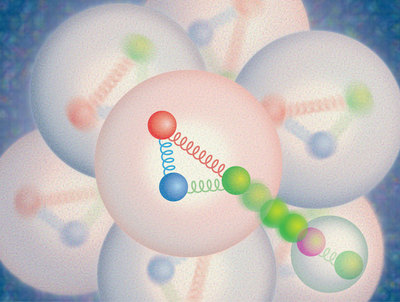| ||
|
The atom is made up of three types of particles. There is the electron which zips around the core of the atom at up to 10% of the speed of light. Its orbit reminds us of planets and its motion is dynamic and exciting. There is also the proton, that massive particle which sits at the core and by the strength of its attractive charge holds that meteor-like electron in orbit. The two of them determine the atom's shapes, its chemistry and its dynamics. And then there is the neutron. It is neutral. It is a non-participate in the atomic dance where the proton swings its partner widely. It appears to be a spectator in the atom, a microscopic pebble. However the neutron really does have its own life. Its surface is boiling with new particles and its heart is alive with quarks and gluons, and in the last dozen years we have developed a clearer view of this active particle. It is just that when we look at the atom we were looking at the world at the wrong scale, the wrong magnification to see the really vibrant neutron. To understand the neutron we need to look at a length scale 100,000 times smaller than the atom. To get a feel for that size, consider this; a red-blood cell is about 10-5 meters across, and about 100,000 times smaller then a human. An atom (10-10 m) is 100,000 times smaller then a blood cell, and a neutron or a proton is about 100,000 times smaller then an atom. This distance is a `femtometer', but in the particle and nuclear physics community it is usually referred to as a `fermi', both with the abbreviation `fm' (1 fm = 10-15 m). Still 100,000 is a hard number to think about. If an atom was magnified to the size of Rhode Island, the nucleus would be the size of a human wandering around inside that state, and except for the electron orbiting along the border, the rest of the state would be empty. Within the nucleus itself the protons and neutrons are tightly packed. Think of a stack of oranges at the market, or better yet a stack of apples and oranges mixed together to describe the two types of nucleons. We use the word nucleon because there are so many similarities between protons and neutrons, they have about the same size and mass. Nucleons have a diameter of 1.7 fm, so a large nucleus, like the core of a uranium-238 atom (238 nucleons) has a diameter of about 15 fm. If we look at the simplest atom, hydrogen, it is made up of an electron and a proton, the neutron is optional. However if we look at any other element, there will be a neutron present. After hydrogen, the simplest type of atom is Helium-3 (3He). It is made up of two electrons, two protons and one neutron. If you were to remove that neutron the atom would fall apart. The electrostatic repulsion between the protons is too strong for a stable, long lived Helium-2 atom. But with neutrons present, heavier atoms and elements can and do happen. The neutrons is a necessary part of elements beyond hydrogen, but they still seem like the dull cousin of the proton. Their reach is short and they mainly seem to just sit there. Whereas the two protons in helium are holding onto the electrons and tussling and pushing against each other, the neutron is the peacemaker, the buffer which sits between them. It is not simply a wallflower in the atomic dance, it is critical in the formation of nearly everything. Over the past sixty years we have been probing the neutron and the proton to measure their size and to characterize the short ranged nuclear force. In the last forty-five years we have begun to view nucleons as a system made up of smaller particles: quarks and gluons. We are now asking how do these quarks arrange themselves? Do they form planetary systems with orbits like electrons in atoms? Or is the inside of a nucleon an amorphous quark-gluon pudding? To make the problem of studying them even more difficult, as if working at 10-15 meters was not hard enough, we have never seen a solo-quark, and we don't expect to. Still there are ways of teasing information out of a neutron and today's experimental and theoretical work is building up a vision of its anatomy.
|

